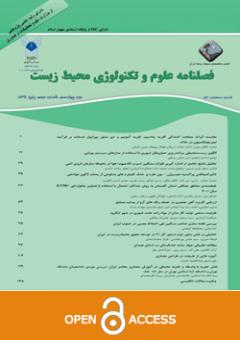Identifying and evaluating environmental reporting quality indicators
Subject Areas : Sustainable Development
Raheleh Nazarian
1
,
Akram Taftiyan
2
*
![]() ,
Forough Heyrani
3
,
Forough Heyrani
3
1 - Ph.D. student in Accounting, Yazd branch, Islamic Azad University, Yazd, Iran
2 - Associate Professor of Accounting, Yazd branch, Islamic Azad University, Yazd, Iran.*(Corresponding Author)
3 - Assistant Professor of Accounting, Yazd branch, Islamic Azad University, Yazd, Iran.
Keywords: Disclosure of hard information, Disclosure of soft information, Thematic analysis, Structural equations ,
Abstract :
Background and Objective: Considering the increasing trend of environmental damage by companies, disclosing information about their environmental performance has an undeniable role in achieving sustainable development. Environmental reporting has become one of the basic issues in the process of sustainable development to ensure environmental protection; the purpose of the current research is to identify and evaluate the quality indicators of environmental reporting to respond to the needs of stakeholders in line with the goals of sustainable development.
Material and Methodology: This research is descriptive-correlative in nature and practical in terms of purpose. The research was conducted with a mixed approach in two parts, quantitative and qualitative, where qualitative data was collected through semi-structured interviews with academic and executive experts in environmental, reporting fields and literature review of the research field. In order to collect quantitative data, a researcher-made questionnaire was given to faculty members, capital market analysts, financial managers and auditors.
Findings: The findings from the qualitative part using the Attride-Stirling theme analysis method include 2 global themes, 7 organizing themes and 39 basic themes. Overarching themes include environmental hard disclosure and soft disclosure. In the quantitative part, the algorithm of data analysis using the partial least squares (PLS) method, which includes the examination of measurement models and structural model fitting; In order to evaluate 7 components, "future perspective and strategic plans, history and specifications, initiatives, disclosure of governance structure and management systems, credibility, financial indicators, performance factors" were used as a tool for measuring environmental reporting in Iran.
Discussion and Conclusion: According to the results of the confirmatory factor analysis and data fitting algorithm, it is possible to understand the acceptability and desirability of the existing structure at the level of themes. Based on this, it can be said that the indicators for measuring the quality of environmental reporting have adequate construct validity and reliability, so they can be used to evaluate the quality of environmental reporting in terms of its reliability.
1. Nurunnabi, M. 2016. Who cares about climate change reporting in developing countries? The market response to, and corporate accountability for, climate change. Environment, Development and Sustainability, 18(1), 157-186. doi: 10.1007/s10668-015-9632-3
2. Amani Babadi, S., A. Salehi, M. Khodamoradi, and A. Jorjorzadeh. 2021. The Effectiveness of Selecting the Most Effective Carbon Disclosure Strategy in the Presence of Stakeholder Anomic. Journal of Environmental Science and Technology, 23(12): 153-168. (In Persian)
3. Benlemlih, M., and Cai, L. 2020. Corporate environmental performance and financing decisions. Business ethic, the environment and resposibility, 29(2), 248-265.
4. Nazarian, R., Taftiyan, A., & Heyrani, F. (2021). Examination of environmental reporting motives: meta - synthesis application. Value & Behavioral Accounting, 6(11), 341-382. (In Persian)
5. Javadipour, A. 2018. A review of social and biological accounting research. Scientific Journal of Acoounting and Social Interest, 8(2), 121-137. (In Persian)
6. Garriga, E., and D. Melé. 2004. Corporate social responsibility theories: Mapping the territory. Journal of business ethics 53(1-2): 51-71.
7. Abbasi Astamal, M., Zeinali, M., Baradaran Hassanzadeh, R., & Badavar Nahandi, Y. 2021. Fuzzy Gap Analysis of Sustainable Development Accounting Disclosure Factors with Mixed Approach in Iran. Biannual Journal of Scientific Governmental Accounting, 8(1), 29-52. (In Persian)
8. Wachira, M., and D. Mathuva. 2022. Corporate Environmental Reporting in Sub-Saharan Africa: A Literature Review and Suggestions for Further Research. Advances in Environmental Accounting & Management, 10: 159-182.
9. Haller, A., and C. van Staden. 2014. The value added statement–an appropriate instrument for integrated reporting. Accounting, Auditing and Accountability Journal, 27(7): 1190-1216.
10. Liberti, J., and M. Petersen. 2019. Information: Hard and Soft. Review of Corporate Finance Studies, 8(1): 1-41
11. Vinh Khuong, N., T. Thuy Khanh, P. Anh Thu, and B. Ngoc Linh1. 2020. Corporate Environmental Disclosure Practices in Vietnam. Research in World Economy, 11(1): 143-152.
12. Papa, M., M. Carrassi, A. Muserra, and M. Wieczorek-kosmala. 2022. The impact of the EU nonfinancial information directive on environmental disclosure: evidence from Italian environmentally sensitive industries. Mediatory Accountancy Research, 30(7): 87-120.
13. Diyanati Deilami, Z. 2018. Quantitative and qualitative research methods in accounting. Tehran: Adalat Novin Publication. (In Persian)
14. Davari, A. and A. Reza Zadeh. 2014. Structural equation modeling. Jahad Daneshgahi Publication, Third edition.
15. Miles, M., Huberman, A., & Saldana, J. 2020. Qualitative data analysis: A method sourcebook. Fourth edition.
16. Attride-Stirling, J. 2001. Thematic networks: An analytic tool for qualitative research. Qualitative research, 1(3), 385-405.
17. Nazarian, R., Taftiyan, A., & Heyrani, F. (2023). The Application of Atride Stirling's Theme Analysis in the Analysis of Environmental Reporting Indicators. Value & Behavioral Accounting, 7(14), 405-432. (In Persian)
18. Abedi Jafari, H., Taslimi, M., Faghihi, A., & Sheikh zadeh, M. (2011). Content Analysis and Theme Network: A simple and efficient way to explain patterns in qualitative data. Strategic Management Thought, 5(2), 151-198. (In Persian)

